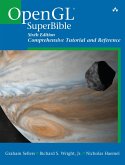Includes Complete Coverage of the OpenGL® Shading Language!
Today's OpenGL software interface enables programmers to produce extraordinarily high-quality computer-generated images and interactive applications using 2D and 3D objects, color images, and programmable shaders.
OpenGL® Programming Guide: The Official Guide to Learning OpenGL®, Version 4.3, Eighth Edition, has been almost completely rewritten and provides definitive, comprehensive information on OpenGL and the OpenGL Shading Language. This edition of the best-selling "Red Book" describes the features through OpenGL version 4.3. It also includes updated information and techniques formerly covered in OpenGL® Shading Language (the "Orange Book").
For the first time, this guide completely integrates shader techniques, alongside classic, functioncentric techniques. Extensive new text and code are presented, demonstrating the latest in OpenGL programming techniques.
OpenGL® Programming Guide, Eighth Edition, provides clear explanations of OpenGL functionality and techniques, including processing geometric objects with vertex, tessellation, and geometry shaders using geometric transformations and viewing matrices; working with pixels and texture maps through fragment shaders; and advanced data techniques using framebuffer objects and compute shaders.
New OpenGL features covered in this edition include
Today's OpenGL software interface enables programmers to produce extraordinarily high-quality computer-generated images and interactive applications using 2D and 3D objects, color images, and programmable shaders.
OpenGL® Programming Guide: The Official Guide to Learning OpenGL®, Version 4.3, Eighth Edition, has been almost completely rewritten and provides definitive, comprehensive information on OpenGL and the OpenGL Shading Language. This edition of the best-selling "Red Book" describes the features through OpenGL version 4.3. It also includes updated information and techniques formerly covered in OpenGL® Shading Language (the "Orange Book").
For the first time, this guide completely integrates shader techniques, alongside classic, functioncentric techniques. Extensive new text and code are presented, demonstrating the latest in OpenGL programming techniques.
OpenGL® Programming Guide, Eighth Edition, provides clear explanations of OpenGL functionality and techniques, including processing geometric objects with vertex, tessellation, and geometry shaders using geometric transformations and viewing matrices; working with pixels and texture maps through fragment shaders; and advanced data techniques using framebuffer objects and compute shaders.
New OpenGL features covered in this edition include
- Best practices and sample code for taking full advantage of shaders and the entire shading pipeline (including geometry and tessellation shaders)
- Integration of general computation into the rendering pipeline via compute shaders
- Techniques for binding multiple shader programs at once during application execution
- Latest GLSL features for doing advanced shading techniques
- Additional new techniques for optimizing graphics program performance
Dieser Download kann aus rechtlichen Gründen nur mit Rechnungsadresse in A, B, BG, CY, CZ, D, DK, EW, E, FIN, F, GR, HR, H, IRL, I, LT, L, LR, M, NL, PL, P, R, S, SLO, SK ausgeliefert werden.









